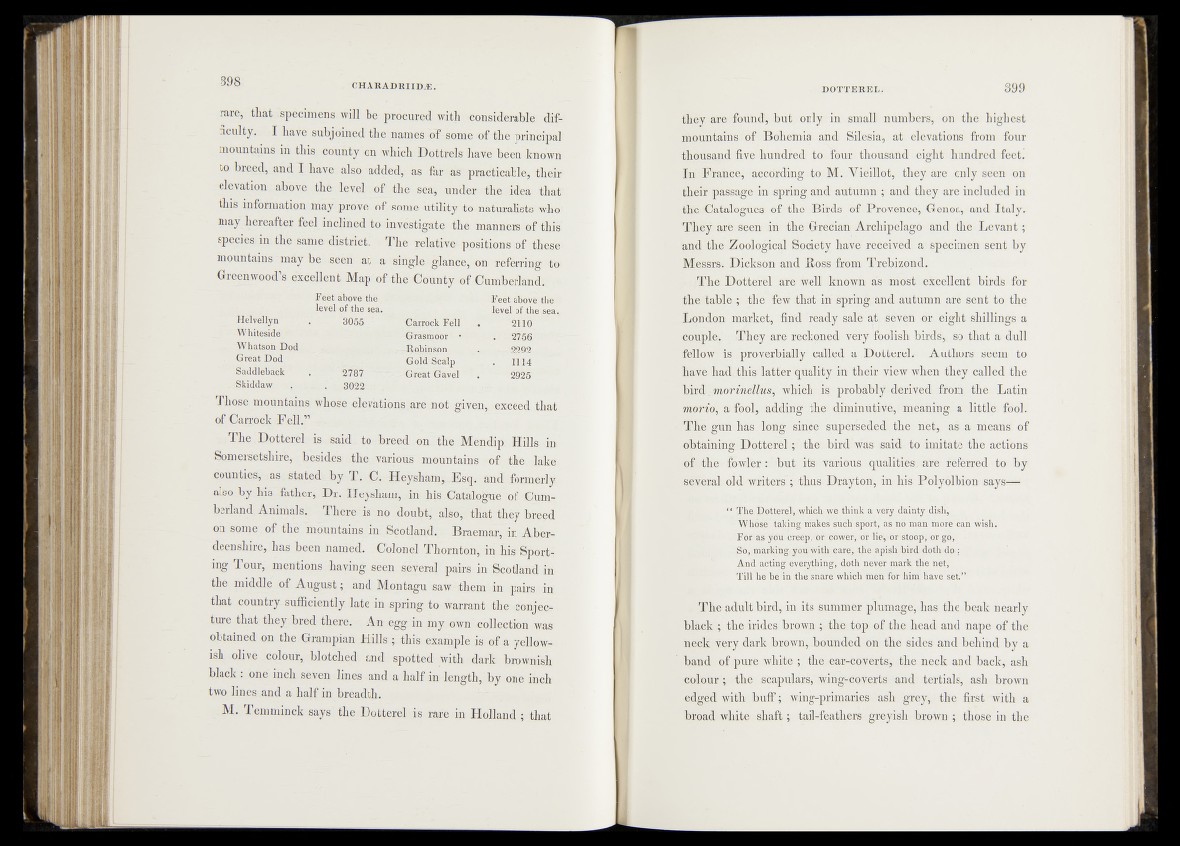
rare, that ^specimens. will be procured with, Considerable difficulty
I have subjoined the names ^'Som^iof^lit^priiLcipal
mountains, in this- .county on which Dottrels have, been known
to breed* and I have al^p "added,- as faiv-as praeti^Mei; their
elevation above the level the sea', under-the- idea that'
this informatienfmay proved of sonfe^tilit^^o. naturalists wbo
mayhereaffei: feel inclined to investigate'.the mannersfbfithis
species in the same district.’ The ^elatwe-positions of ticse*
mountains mdy b ^seefi at a ^sftgle^pagC^ on -referring 4 ft
Greenwood’s excellent Map of the Csipsfcy <<*£ Cumberland:
F eet above^’tïÆ.
level pfthe sea.
Helvellyn" ' ’ il^ '^ 0 5 5^ -'
Whatsoh Dod
Great Dod
Sadâlëbaclf''’ . - 2 707'^
Skiddaw , , _j.
F eet-aJöa'vt^b]1'6*--'
I level oi the sea*
Caxrock Fell * “ 2 ® ^ ^
•j&fâÊM§ar ' r* . '
Robinson
'(j’dfd^Scalp r . l f fT
GieafSave'l ** :l
Those mountains whose-elevations .are not *given, exceed that
of Garrock -FelL’T r-
The 'Dottereb is. saidf todareed/.on the Mendip. Hills, in
Somersetshire,-y besides- u the;* Various' mountains '.xof^^be/ijake
counties, *as. stated J jy T. C. Heysham^Sse[^;and fbrj^aprly
also by his fa th 4 | Dr. 'Heysham, in his £!atalagote ol*,GVn-
berland Animals. There"is no doubtj alsb,'. th atS ey breed
on some" of the' moiuitains, iny/Scotland. Braemar/nn „Aber->
deenshire,! has been named. Colbnel--Thorntoii, in Jhis Sport-!
ing Tour, mentions having seen several pairs in Scotland in
th e.n ii^^ , of August; and Montagu'saw them in pairs in
that country_sufficiently late in, spring, to warrant thevkoonjecsT
ture that--they-bred there.; u. A-nregg in my own collection was
obtained on the Grampian Hills ; this example is' of a yellowish,
olive colour,«^blotched and.'-spotted with dark brownish
black : one inch seven lines and a half in-length, by One inch
two lines.and a half in breadth.
M. Temminck says’ the Dotterel is rare in Holland ; that
thev are found, but only in .small numbers, on the highest
rnounfainssof Bohemia and Silesia, at elevations from four
thous^ndifive/ hundred doopur thousand eight hundred feet.
In France,-;îa'ccdçding fo iëillot, they are only seen on
then: lissage in spring, Éad autumn ; and they are included in
th'ê^fWalogùea; oi^th^ Birds of.Brovence, Genoa, and Italy.
Thiéÿyarbss®eU^èn the Grecian Archipelago and the Levant ;
*amd ’the r^u@J®§i(^LfS,bei’éty hav'e! received*! a specimen sent by
Messrs...Difpon and Bp^S^from. Trebizond.
^/Tke„D^tsfeprfel ,ate well known a lm o s t eicellent birds for
,dh@f fable,:;-- .the-ifewlihabirf spring and autumn arè sent to the
London m^kfet^rfind readyysaié at, seven nr, eight shillings a
cpupl® They *aa?e reckoned- very roolish birds, that a dull
felJbwISis .proverbially called a .Dotterel* Authors seem to
basé had this îfatter Quality in their view when they called the
bird jnorin&Uiis, which is;ypr.obablÿ-fd©riyedî from the Latin
morié^'a<fot>lfIl(dd|ng -thé diminû|hyé,wmeaning a little fool.
superseded the net, as a means of
Éptaini-ng DottérbL bird'was said, to imitate the actions
of K h ^ ïÇ ^ ^R ^ b u t ïts‘-.îvalions ' qualit^est/are rèferredfo by
several old writers"; thus Drayton-, in his Polyolbion says—
“ The Dtfeterdsjwhiqjb we think a very dainty dish,
• WKo^tSklpg mates such sport, as no man more can wish.
For as you-creep’,»of cower*-dr lt^ h r stoop, or gö, »
|S|§ p p a rk in g you with carfeUtJie apisfrftird.doth do;
And aeting' everything, doth perer, mafic the net,
Tilt he oe.in thé snare which men for him have set.”'
, The adulitjbird, in• its summer plumage, has the beak nearly
blacky the. hides brown ; ithq-ftop ^ t h e -head and nape of the
neck very dark brownf,.bounded on the sides and behind by a
band of pure white; the ear-coverts, the neck and back, ash
ctdour; the scapulars, wingrcoyerts; and tertials, ash brown
edged with buff“; wing-primaries ash grey, the first with a
broad white shaft; tail-feathers greyish brotvn ; those in the